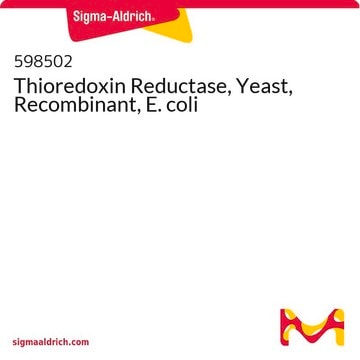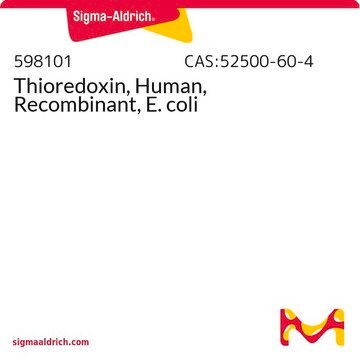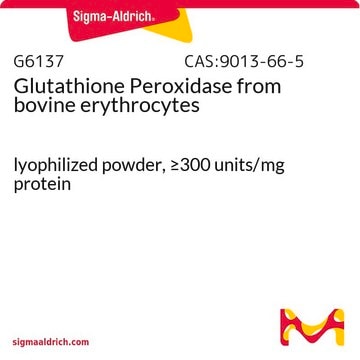T9698
Thioredoxin Reductase from rat liver
buffered aqueous glycerol solution, ≥100 units/mg protein (Bradford)
Sinónimos:
NADPH:Oxidised Thioredoxin Oxidoreductase, Thioredoxin: NADP+ Oxidoreductase
Seleccione un Tamaño
Seleccione un Tamaño
About This Item
Productos recomendados
origen biológico
rat liver
Nivel de calidad
Ensayo
≥90% (GE)
Formulario
buffered aqueous glycerol solution
actividad específica
≥100 units/mg protein (Bradford)
mol peso
55—67 kDa
técnicas
activity assay: suitable
impurezas
Glutathione reductase
solubilidad
water: soluble
idoneidad
suitable for molecular biology
Nº de acceso UniProt
Condiciones de envío
dry ice
temp. de almacenamiento
−20°C
Información sobre el gen
rat ... Txnrd1(58819)
Descripción general
Aplicación
Acciones bioquímicas o fisiológicas
Definición de unidad
Forma física
Código de clase de almacenamiento
12 - Non Combustible Liquids
Clase de riesgo para el agua (WGK)
WGK 1
Punto de inflamabilidad (°F)
Not applicable
Punto de inflamabilidad (°C)
Not applicable
Equipo de protección personal
Eyeshields, Gloves, multi-purpose combination respirator cartridge (US)
Elija entre una de las versiones más recientes:
Certificados de análisis (COA)
¿No ve la versión correcta?
Si necesita una versión concreta, puede buscar un certificado específico por el número de lote.
¿Ya tiene este producto?
Encuentre la documentación para los productos que ha comprado recientemente en la Biblioteca de documentos.
Los clientes también vieron
Artículos
Cellular oxidative stress is countered by enzymatic scavengers and antioxidant modulators against reactive oxygen species damage.
Active Filters
Nuestro equipo de científicos tiene experiencia en todas las áreas de investigación: Ciencias de la vida, Ciencia de los materiales, Síntesis química, Cromatografía, Analítica y muchas otras.
Póngase en contacto con el Servicio técnico










